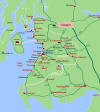
Day Three - Isle of Bute & Mount Stuart
return to 2019 UK trip index
return to mdimage site index
We drove from from Plean back through Glasgow, heading west to the tiny port of Wemyss. About two hours later, we arrived just in time to board the noon CalMac ferry to Rothesay, on the Isle of Bute, a 35-minute crossing of the Firth of Clyde.
CalMac is short for Caledonian-MacBrayne, the company that operates ferries throughout the Inner & Outer Hebrides Islands. Their ships are comfortable indoors & out, and the mini-cafe had good machine coffee.
.. |
look for Wemyss & Isle of Bute at upper left |
note - you can enlarge any part of a picture by left-clicking in and then out again.
note - the attractive mountain profile seen behind Rothesay is on the Isle of Arran, a popular hiking destination to the west of Bute.
Once landed we had a humorous adventure finding the Ardyne Guest House, our one-night B&B stay. We checked in & drove a few miles south to Mount Stuart, a popular destination.
MOUNT STUART
Rebuilt after a fire in the late 1870s, by the 3rd Marquess of Bute, Mount Stuart is "a flamboyant example of 19th century Gothic Revival architecture", according to Wikipedia.
Historically, the Bute family were Stuarts, direct descendants of King Robert Bruce (1274-1329). As was often the case back then, relatives of the Royals were given huge land holdings to manage, over time hopefully becoming a source of moderate income or even wealth.
The branch of Stuarts who became the Earls of Bute (and later the Marquesses of Bute) struck gold in the form of coal mines on the lands they were given, or inherited through marriage.
The Bute family developed their mining interests and become the sole source of coal for the entire Country of Wales, and by 1860, the Butes were the wealthiest family in Great Britain.
Overview of the Bute family - Once back at home, I read the beautiful 50-page official brochure in January 2020, and found that Bute family history includes a few really interesting characters, so at the bottom of this page there's a more extensive chronology.
The quick take is that immense wealth came into the hands of a few amazing & influential persons among the many Bute family members who lived here in the 1700s & 1800s.
In the bigger picture, two of note are the 1st Earl of Bute & the 3rd Marquess of Bute, who were responsible (respectively) for constructing the first (1716) and the second (1890) Mount Stuart homes.
note - you can enlarge any part of a picture by left-clicking in and then out again.
ROTHESAY
That evening we enjoyed dinner in center-city Rothesay, which barely exists. So many buildings are undergoing badly-needed renovation.
Guidebooks call Rothesay "a faded Georgian town".
The 2nf floor dinning room in the Victoria Hotel had a terrific sunset view, looking north, across the Firth of Clyde, towards the legendary Scottish Highlands. In the foreground note the palm trees.
 |
Inner Hebrides Islands |
 |
Scottish Highlands |
Speaking of legendary, the sticky-toffee pudding here took on legendary proportions as our trip progressed, as it could not be bested, the wives being the primary judges. They tried it everywhere we went for dinner, and it was usually on the menus. The first was the best !
Don't let the word "pudding" throw you, because in Scotland pudding is a general word for "dessert".
This is a square block of moist dark cake, made of molasses & dates, served in a bowl, surrounded by a pool of warm sauce made from caramelized brown sugar, a lot of butter, and whipping cream. Warmed-up cake & sauce tend to be served with a scoop of vanilla bean ice cream.
I tried a sample & the various ingredients complimented each other perfectly, perhaps the best dessert I've ever had (a bite of).
 |
sticky toffee pudding (web photo) |
go to next page - Ayrshire - Dean Castle & Culzean Castle
return to 2019 UK trip index
return to mdimage site index
~~~~~~~~~~~~~~~~~~~~~~~~~~~~~~~~~~~~~~~~~~~~~~~~~~~~~~~~~~~~~~~~~~~~~~~~~~~~~~~~~~~~~~~~~~~~~~~~~~~~~~~~~~~~~~~~~~
Bute Family History - all info below is from the official Mount Stuart brochure. (Please feel free to skip this section, if you are not a history nut, or for any other reason.)
1315 - Walter Steward married the daughter of King Robert Bruce, their son in time becoming King James IV of Scotland. This branch of the Stuart family tree took on the place-name of Bute, once they were appointed as hereditary keepers of Rothesay Castle, on the Isle of that name. So off they went and lived in the Castle for the next 350 years. The small town of Rothesay grew up around them, in a beautiful & protected waterside setting.
In 1685, Oliver Cromwell demolished Rothesay Castle as part of England's Civil War. Following the restoration of Royalty, in 1703, James Stuart, 3rd Baronet, was made 1st Earl of Bute, a royal promotion, and by 1716 he had constructed the original Mount Stuart on some waterfront land further south on the Isle.
Two generations later, John Stuart (1713 - 1792), the 3rd Earl of Bute, somehow became a friend & then personal advisor to English King George III. He also served as the first Scottish Prime Minister of Great Britain, from 1762-63, but was unpopular, mainly because he was seen as an outsider, being Scottish.
The 3rd Earl of Bute nonetheless became an outstanding collector of European art, especially Dutch paintings, and later, Italian Renaissance & Germanic Baroque paintings. The Docent told us that the collection he handed down is so vast that it has yet to be fully audited.
For instance, in 2016, research staff found a Wm. Shakespeare First Folio, from 1623, not that rare as there are still about 250 FFs around today. But still...the 3rd Earl was a connoisseur of valuable art.
John Stuart (1744-1814) the 4th Earl of Bute was given the title of 1st Marquess of Bute in 1796, another royal promotion. Bute's wife Charlotte Windsor was heiress to a huge land estate in South Wales, and, just like that, the Bute family's properties & wealth increased. He was a bit of a rake and liked to hang out in wealthy circles in London, where everyone called him "Mountstuart". In the 1770s he even fell in with Samuel Johnson's Club members.
John Crichton-Stuart (1793-1848), the 2nd Marquess of Bute was a brilliant person who expanded the family fortune by developing South Wales, in particular by turning the almost non-existent town of Cardiff into the largest coal exporting docks in the world. He seems to have developed a talent for large scale engineering & construction projects, and, his son of the same name followed in his footsteps.
The 3rd Marquess of Bute - In the 1860s, when John Crichton-Stuart (1842-1900) turned 21, he was by inheritance the wealthiest person in Great Britain. His 300,000 pounds a year annual income would be equivalent to $0.5 B today.
He was a thoughtful & complex man, a scholar, historian, theologian, and was called "the best non-professional architect of his generation."
He became a master at overseeing the renovation of historic buildings. In south Wales, he & master Architect Wm. Burgess began their careers in the 1870s renovating the "ethereal and wondrous" Cardiff Castle, originally an 11th Century Norman tower. In the process, they also excavated & rebuilt a number of 3rd Century Roman structures on the Castle grounds, in the original style. The interiors at Cardiff Castle are said to be "the most magnificent ever achieved by Gothic Revival style." Not a bad start!
As a philanthropist/builder, over time the 3rd Marquess restored many historic buildings in Scotland. Among his 60 projects were the modernization of Falkland Palace, the gift of Bute Hall to Glasgow University, and, the archaeological excavations at Whithorn, "the cradle of Scottish Christianity," at St. Andrews, important to Catholics.
Mount Stuart was partially destroyed in a fire in December 1877, although most of the artworks were rescued by the brave staff. The 3rd Marquess of Bute is responsible for today's Mount Stuart, with its magnificent Gothic exterior & sumptuous interiors. He hired an architect but acted as idea-man and general contractor/builder, personally supervising a group of craftsmen & artists with whom he had worked for 20 years.
This is why the quality of materials used, and, the seamless workmanship at Mount Stuart is so impressive. Master craftsmen built this home as a "state of the art" architectural expression, for instance, using 32 different kinds of Italian marble, some rarely seen.
The brochure states that the 3rd Marquess of Bute had an interest in esoteric science and was the source of all architectural references to Astrology & Astronomy, yet he was a devout Catholic & towards the latter part of his life served a few terms as Rector of St. Andrew's University. He was a Catholic outlier in an otherwise Protestant family tree, a complex man, as stated.
My guess after visiting is that the 3rd Marquess of Bute wanted Mount Stuart, at every possible level, to be perceived as a work of art, and a display of superb craftsmanship, and I think he succeeded. I had certainly never seen anything like Mount Stuart before, and was speechless afterwards, a rare state for me.
When the 3rd Marquess of Bute died in 1900, it heralded the end of an era, Mount Stuart being in an unfinished state, as it remains today.
In 1989, the Mount Stuart Trust was established & in the present time continues to develop & care for the house & estate. Tourists are a constant influx of funds to the Trust.
 |
poster on the CalMac ferry |
go to next page - Ayrshire - Dean Castle & Culzean Castle
return to 2019 UK trip index
return to mdimage site index